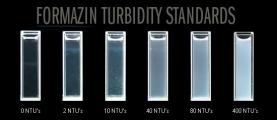Color, Turbidity and Philosophy
When we humans look at objects we describe them in terms of color. We say that an apple is red or the sky is blue. To us color is an attribute just as surely as its mass or dimensions. But the fact is that color is a pure human construct. Take away the human and it does not exist. What we perceive as color is really just our brains interpretation of the range of wavelengths that the object reflects or (like Christmas tree lights) emits and that our retinas perceive. When a beam of white light strikes a red delicious apple, it absorbs most of the blue and green wavelengths. The wavelengths of light that lie in the red end of the visible spectrum are not absorbed and, hence, reflect off the apple and into our eyes. The absorption of light as a function of wavelengths is complicated and different for every object. That’s why we refer to an object’s spectrum as its “fingerprint.” A red object has a different absorption spectrum than that of a fire truck. The amount of light absorbed at every wavelength—the absorption spectrum—is unique to the apple. It’s an intrinsic property of the apple.
If I shine an incandescent light on the apple its color looks different to us than if we place the apple under a fluorescent light. Color is not an intrinsic property. It’s an invention of our brains. You can look up in a reference book the absorption spectrum of any object and for any wavelength between radio waves and x-rays. But you can’t look up the color because it doesn’t exist outside of our visual cortex. (By the way, the reason we can mix the three primary (additive) colors—red, green and blue—to make any other color is simply because the our retinas contain red, green and blue receptors.)
Why this little treatise on color? Because turbidity is just like color—it’s not an intrinsic property of a sample. It’s a measurement of how cloudy that sample is. You might reply that you can put a number on turbidity but you can’t put a number on color and you’re right. In this country we use a nephelometric turbidity that conforms to EPA Method 180.1. This means that the light source is an incandescent light bulb and the detector measures light at a right angle. But that scattered light intensity—typically in NTU’s—is dependent on a lot of variables: spectrum of the light source, focusing optics, collection optics, detector response. Even with EPA’s prescription for making a turbidimeter no two are alike. You might calibrate two instruments at, say a 1 NTU calibration standard, only to find that they give different values at a 0.01 NTU standard.
In one sense the wastewater (or should I say the “water resource recovery”) people have had it right all along. If suspended solids are what make light scatter then why not measure the suspended solids directly? EPA Method 160.2 prescribes a very simple and inexpensive way to measure total suspended solids (TSS). The only drawback is that it is barbarically slow. So wastewater operators use an in-situ turbidity sensor that has been calibrated for TSS readings. For reporting purposes Method 160.2 is sill the definitive test but, for operational purposes, the turbidity sensor is a time saving surrogate.
Why this little treatise? Two reasons: For one, if you are in the business of measuring turbidity then you need to know it is a subjective measurement. Our limited efforts to make it objective means that you need to treat a turbidity value within the context of the machine that measured it. Two very different samples of water can give the same turbidity value and two turbidimeters can give two different readings.
The second reason is because it’s interesting. Until this last century scientists were philosophers. From the time he was a young genius, Einstein and his colleagues debated the meaning behind the laws of nature. Do scientific theories explain what we humans observe or do they explain fundamental truths about the universe that hold true even if we never existed. The concepts of color and turbidity fit nicely into that debate.